White Wall Paint:
It's a Color, Too
White wall paint is probably the most popular choice for interior painting.
But that doesn't mean white is the easiest color to work with for painting and decorating a home.
The color white is synonymous with cleanliness and freshness, and is commonly thought to help create a feeling of space and light in a room.
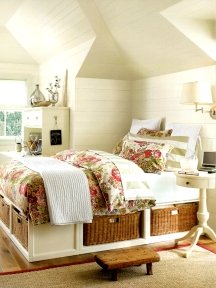
When used in large amounts in a home, it is believed to encourage a clear mind, de-clutter the senses, and provide a perfect backdrop for imagination and creativity.
Because of these connotations, white wall paint is common in many homes - from kitchens, bathrooms and bedrooms to living room and hallway spaces.
But white is also deceptively simple, and despite its popularity, doesn't always look good on the walls - not because it's not a good wall color per se, but because it's often chosen and used incorrectly or without much thought at all.
Too many people think that white is white is white, but...
Not All White Is Really White
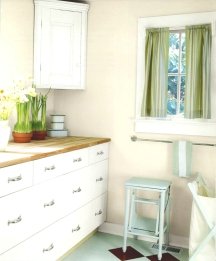
White is a very popular painting and decorating choice because it's considered completely foolproof and safe.
Most people think that since it's not a "real" color, no one will find it offensive, and that being a neutral, it should just go with everything.
But not everyone realizes that white wall paint can also look
incredibly cold, sterile, cheap and unattractive if the shade is wrong, and that choosing the right white should take as much consideration as any other "real" color.
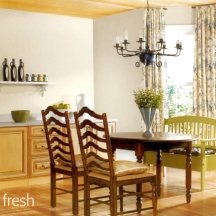
The thing is, white paint colors come in a great many subtle variations, also known as undertones.
When you look at each one individually, usually all you see is plain white.
But when viewed and compared together, it becomes obvious that shades of white can be warm, cool, dull, bright, faded, yellow, pink, green, gray and so on.
That's
why not every white will work with your decor and fixed elements (tile, countertops, carpets, etc),
and wrong combinations can clash, or look too harsh or dirty.

And not all whites go well together either!
When using white paint in a home, one of the most common mistakes people make is not being consistent.
For example, they paint the ceiling a cool white, the walls a warm white, and the woodwork an off-white shade (usually because each surface was re-painted at a different time with a different product).
As a result, even though all the surfaces are white, they still
look mismatched and unrelated - because their temperatures and
undertones were not coordinated or aligned.

Sometimes it can be a good idea to layer and combine different shades of white for variety and depth (especially in all-white rooms).
But they must be selected carefully to make sure they look harmonious and consistent together - in other words, you must know what you're doing!
So when in doubt, use the same shade of white everywhere, but vary the sheen level (flat on the ceiling, satin on the walls, and semi-gloss on the woodwork).
White Wall Paint: Just Add Texture And Light
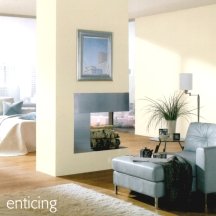
White wall paint colors require lots of natural and artificial light to look fresh and clean.
Otherwise, even the most gorgeous and delicious shade will appear dingy, bleak and dull.
Don't fall for the myth that says white makes a room appear lighter, because white itself needs light to look bright and light (if you want to add light with color, paint the room yellow).
In addition, natural textures, fibers and a variety of sheens are a must in all-white rooms to keep things interesting - think fur, metals, stone, glass.
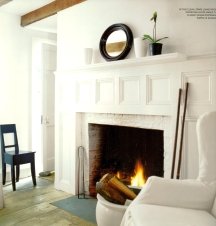
Keep in mind that white-based room color schemes can look as bold or as understated as you wish - the result will depend on what other colors you pair the white with.
For example, white walls look really smart and chic when combined with grays.
Black and white paint color scheme also looks classy and timeless.
But natural wood (flooring, furniture or woodwork) is needed to add
some much needed warmth and a hint of color to such achromatic schemes.
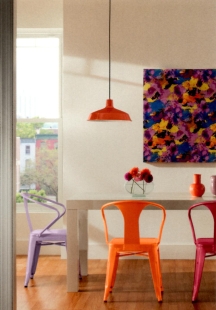
You can create an elegant and sophisticated palette by pairing white with subtle tints or shades of other colors - light sage greens, grayed blues, or pale beiges.
Or you can choose to add a punch of strong color with a few strategically placed decorative accents or wall art.
Just a touch of red, cobalt blue, lemon yellow or lime green will go a long way here, because all colors appear twice as bright on a white background.
TIP: white requires a commitment - you can't just paint one room white and have the rest in color, because your single white room/area will just look unfinished - as if you've just primed but haven't painted it yet. So when it comes to white walls, go big or go home - either paint your entire house white, or don't even bother.
Don't feel like going through hundreds of white wall paint colors to find the right one for your home?
Check out the Paint Color Cheat Sheets for my 6 best shades of white.
White Room Projects
From Our Visitors:
Have your own white room painting project to share? Click here and see your name in lights!
Simple White Wall Paint Color: Our Living Room Makeover
When we first bought the house, this living room was painted a pretty bright orange color and everyone hated it. So of course it was the first on the list …
My White Japan Inspired Basement
I like Japanese style, and that's what I was going for here. Though most of the items in my room do not in fact have much to do with Japan, there is without …
Custom Mixed White Wall Paint Color in My Living Room
Hey this is my freshly painted white living room.
I used white color paint and added a few drops of black paint to get the desired effect - as you see …
Our White Painting Idea for a Living Room
We wanted to use an earthy color scheme in our house, so we started by painting the walls white (we used Asian Paints in a lustre finish).
All of …
See Also:
Purple Paint: the Mysterious Color













Leave a Comment: